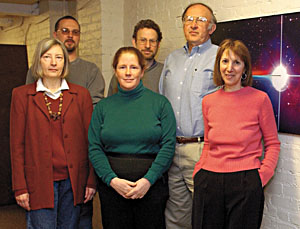 | The camera that helped spot the new planetoid -- named Sedna, after the Inuit goddess of the sea -- was constructed by a team of Yale scientists that included (from left) Suzanne Tourtellotte, Tom Hurteau, Nancy Ellman, David Rabinowitz (a member of the discovery team), Charles Baltay and Rochelle Lauer. |
NASA and a team of researchers from the California Institute of Technology, Yale and Gemini Observatory have reported the discovery of the most distant object in the solar system.
Nearly the size of Pluto and more than three times as far away, it has been designated "2003 VB16" and unofficially named "Sedna."
The discovery was made on Nov. 14 with a specially constructed detector mounted on the 48-inch-diameter telescope at the Palomar Observatory in California. The "planetoid" was verified by telescopes in Spain, Arizona, Hawaii and Chile operated by the SMARTS (Small and Moderate Aperture Research Telescope System) Consortium, set up by Yale and 10 other U.S. institutions to provide access to small research telescopes in the southern hemisphere. NASA's Spitzer Space Telescope was unable to detect it at infrared wavelengths, confirming information about its nature and size as a cold object, smaller than Pluto and no more than 1,000 miles in diameter.
The discovery team consisted of Michael Brown at the California Institute of Technology (Caltech), David Rabinowitz at Yale and Chad Trujillo at the Gemini Observatory.
The camera used by the team is one of the largest ever built. A single exposure covers a huge patch of sky, 40 times larger than the full moon. The group will be using this camera to repeat the search of the whole sky that led to the discovery of Pluto in 1930. This time, the search will be 100 times more sensitive. Charles Baltay, professor of applied physics and astronomy at Yale, built the camera -- with over 160 million pixels and 112 CCD detectors -- for the Samuel Oschin Schmidt telescope at Palomar.
Other members of the construction team at Yale were Rabinowitz, William Emmet, Tom Hurteau, Nancy Ellman and Rochelle Lauer. Professor James Musser, Mark Gebhard and Brice Adams designed the electronics at Indiana University.
"In reviewing the whole sky, we are finding some very big objects. This one might be about the size of Pluto, but much further away," says Rabinowitz, a research scientist in the Department of Physics. "The characteristics of this object are consistent with it residing in the 'Oort cloud,' a reservoir of long-period comets like Hale-Bopp that has been hypothesized since 1950."
This new body, three times farther from the sun than Neptune, is nearly 10 billion miles from the sun. Its orbit is elliptical in shape and ranges from roughly seven to 100 billion miles away from the sun.
Information and images are available at www.nasa.gov,
www.gps.caltech.edu/~chad/sedna,
www.astro.yale.edu/smarts,
hepwww.physics.yale.edu/quest/quest_docs/aas_2004a.htm
and www.spitzer.caltech.edu/Media/releases/ssc2004-05.
T H I S
Yale scientist on team that
discovered new planetoid
 W E E K ' S
W E E K ' S S T O R I E S
S T O R I E S![]()
 Project capturing residents' memories of life in Elm City
Project capturing residents' memories of life in Elm City![]()
![]()
 Initiatives whet city students' interest in science, drama
Initiatives whet city students' interest in science, drama
![]()
![]()
 Update on Budget Planning and Business Service Enhancements
Update on Budget Planning and Business Service Enhancements
![]()
![]()
 Miller reappointed as Saybrook College master
Miller reappointed as Saybrook College master
![]()
![]()
 Ambassador Liu applauds Yale's programs in China
Ambassador Liu applauds Yale's programs in China
![]()
![]()
 Center promotes educational cooperation between Yale and Fudan
Center promotes educational cooperation between Yale and Fudan
![]()
![]()
 Study: Time can be factor in treatment of schizophrenia
Study: Time can be factor in treatment of schizophrenia
![]()
![]()
 Yale affiliates abroad can get aid . . .
Yale affiliates abroad can get aid . . .
![]()
![]()
 Levin announces appointments of department chairs
Levin announces appointments of department chairs![]()
![]()
 Zedillo honored
Zedillo honored
![]()
![]()
 Campus Notes
Campus Notes
![]()
Bulletin Home |
| Visiting on Campus
Visiting on Campus |
| Calendar of Events
Calendar of Events |
| In the News
In the News![]()
Bulletin Board |
| Classified Ads
Classified Ads |
| Search Archives
Search Archives |
| Deadlines
Deadlines![]()
Bulletin Staff |
| Public Affairs
Public Affairs |
| News Releases
News Releases |
| E-Mail Us
E-Mail Us |
| Yale Home
Yale Home